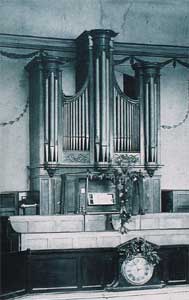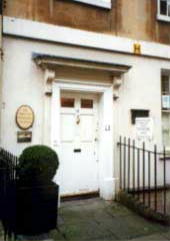A E Fanning
Until he finally settled in what later became known as Observatory House in 1786, William Herschel led a very peripatetic life, seldom remaining in the same house for more than a few years. Arriving in London penniless, in 1757, he and his brother Jacob lodged with friends until Jacob returned to Hanover in the autumn of 1759. William, finding London 'overstocked with musicians', accepted a post in Yorkshire as head of the band of the Earl of Darlington's private Militia.
Yorkshire
The job at Darlington gave him plenty of time for other pursuits and for the next two years he traveled widely, mainly on horseback, giving lessons and organising musical occasions. However, although he was much in demand, he was not happy. As he wrote to Jacob, 'I am almost tired of having no home or place to be fixed in... I do not know what will become of me at the last...'
Some years later a Doctor Miller, organist at Doncaster, is reported to have claimed that he 'discovered' William and invited him to come and live with him but, as William told his son John, this was not true. ('Doctor Miller, it seems, assumed a credit to himself more than his due'.)
In the spring of 1762 William was appointed Director of Public Concerts at Leeds, remaining there for four happy years and lodging with a Mr and Mrs Bulman, who remained good and faithful friends for many years. He moved on in August 1766 to become organist at Halifax but, after only three months, moved on again to take up an appointment as organist of the new, prestigious Octagon Chapel in Milsom Street, Bath.
Bath
 The organ of the Octagon Chapel (not existing now)
The organ of the Octagon Chapel (not existing now)
After staying briefly with Dr and Mrs De Chair, to whom he owed his new position, William found lodgings in Bath but, as the number of his pupils increased, he soon found it necessary to rent a house in Beaufort Square. Here his friends the Bulmans joined him, Mr Bulman having secured the post of Clerk to the Octagon Chapel.
The next move came in April 1770, when William rented No. 7 New King Street, for thirty guineas a year. All three of his brothers visited him here at different times, Alexander finally remaining permanently, and it was to his house that Caroline was brought when she was allowed to join his brothers in 1772. It was here, too, in the following year, that William's interest in astronomy really took off.
During the summer of 1774 the families moved again, to a house on the outskirts of Bath, described as 'situated near Walcot Turnpike'. The house had sheds and stables, to be turned into workshops, and a field for observing, but was inconveniently far from the concert halls so, after three years, they found themselves back in New King Street. The Bulmans had left them, in 1775, to return to Leeds.
The new house, No. 19 New King Street, had a garden, with a southern aspect, and it is a mystery why, two years later (1779) they again moved to the upper part of the town, this time to No. 5 Rivers Street. The house had no garden, which had important consequences for the future. One evening when William was observing the moon from the street, a Dr William Watson stopped to ask if he might take a look. He introduced Herschel to the Bath 'Literary and Philosophical Society', which had just formed, and it was he who read William's early papers to the Royal Society - starting with that on URANUS.

After two years the Herschels moved back to the convenience of No. 19 New King Street where, on 13 March 1781, William made the great discovery which not only changed their lives but altered the whole course of astronomical thinking for ever. The house is now called Herschel House, and is the only one of Herschel's dwellings known to have survived. It contains the Herschel Museum and is the head-quarters of the William Herschel Society.
Quoted from Newsletter No 86 issued by the Herschel Society of Japan